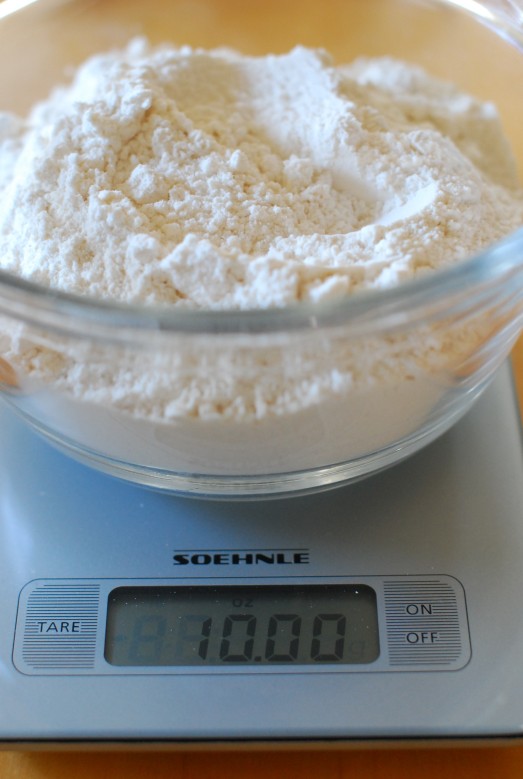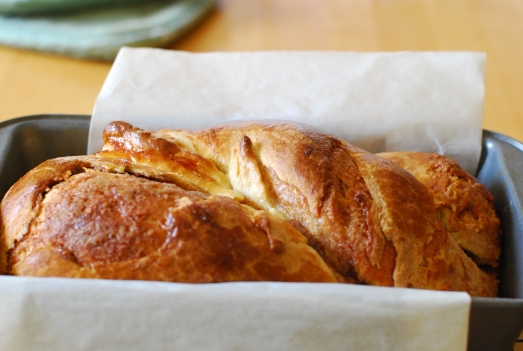When I saw this Babka recipe in my Cook’s Country magazine I was sitting at piano lessons. But that didn’t stop me from lusting after it. I LUUUUUV bread. All bread. Any bread. Rolls, muffins, loaves, whatever. I have rarely met a bread that I wouldn’t gladly give up vegetables for. And this sweet, cinnamony bread is no different. So the next day, I whipped up my first babka. And it’s GOOOOOD. It was good warm out of the oven, it’s good cold, and it’s good made into toast. I haven’t tried it (yet) but I bet it’ll be good as french toast, if it lasts that long.
One word of caution, and this is for bread in general, not just this babka. Successful yeast dough relies upon blooming the yeast properly. That means that you need the right temperature liquid. Don’t guess, take the temperature of the liquid. This recipe calls for you to do that, many do not. Checking the temperature will ensure much more reliable results.
Babke
Recipe courtesy of Cook’s Country
- 1 cup packed (7 ounces) light brown sugar
- 1/4 cup (1 3/4 ounces) all-purpose flour
- 2 tablespoons unsalted butter, melted and cooled
- 1 large egg white (reserve the yolk for the dough)
- 2 teaspoons ground cinnamon
- 1/8 teaspoon salt
Dough
- 1/2 cup whole milk, heated to 110 degrees
- 2 large egg yolks plus 1 large egg
- 1 teaspoon vanilla extract
- 2 cups (10 ounces) all-purpose flour
- 1/4 cup (1 3/4 ounces) sugar
- 1 1/2 teaspoons instant or rapid-rise yeast
- 1/2 teaspoon salt
- 8 tablespoons unsalted butter, cut into 8 pieces and softened
I love to bake. The smell of bread or cookies baking in the oven is my favorite. It warms up the house on a cold day and it puts a smile on the face of anyone who comes in your door!
For the filling, combine all the ingredients in a bowl. Reserve one tablespoon of filling.
For the dough, heat the oven to 200 degrees, when it reaches temperature, turn it off. Whisk together the milk, egg yolks, and vanilla. I separate the eggs using the shell and two small bowls. You can use a fancy egg separator if you have one, but here’s s tip. Shell bits are attracted to the shell from which they came. So, if you should drop a piece of shell in by accident, you can fish it out using the larger piece of shell it came from. Who knew, right? See? Science is good for something.
Using a stand mixer with the dough hook attached, mix flour, sugar, yeast, and salt on low speed. You’ll notice that I weigh my flour instead of measuring it in a cup. I find that this yields much better results with my baking. It’s also convenient to have a scale to weigh other foods. If you don’t have a scale, don’t fret. Fluff your flour before spooning it lightly into the measuring cup for best results.
Once dry ingredients are combined, add the milk mixture slowly and mix until the dough comes together. This should take about three minutes. Set a timer if you need to.
Increase the mixer speed to medium-high and add the butter, one tablespoon at a time, until incorporated. This should take about a minute.
Continue to mix until the dough comes away from the sides of the bowl and is smooth, about 10-12 minutes.
Grease a large bowl, transfer dough to bowl, cover with plastic wrap and place in your turned-off oven. After about an hour, dough will have risen slightly. Remove from the oven and place in the fridge about an hour, or until dough is about doubled in size and is firm.
Reheat your oven to 200 degrees (again). When it reaches temperature, turn it off (again).
Punch down the risen dough on a lightly floured board or counter. I like to square mine up after punching it down.
Roll out the dough to a 20×14 inch rectangle. I use a ruler to make sure I’m close to the measurements.
Spread the filling onto the dough leaving a 1/2 inch margin all the way around.
Start with the short side and roll up the dough into a cylinder. Pinch along the seam to seal. Put the cylinder seam side up and roll back and forth until the length of the dough roll reaches 18 inches.
Spread the reserved tablespoon of filling over the top of the cylinder. Fold the dough in half on top of itself and pinch the ends to seal.
Then, gently twist the cylinder twice as if you’re forming a double figure eight.
All this rolling, folding, and twisting is what gives the babka those yummy nooks and crannies for the cinnamon and sugar filing to get into!
Place your babka, seam side down, in a loaf pan lined with parchment. Let the extra hang over the edges, these will be handles later and it will help you remove the dough from the pan. The parchment also keeps the babka from sticking to the pan should any sugary stuff leak out. Cover with plastic wrap.
Put the bread, covered in plastic, in the turned-off oven until doubled in size, about one hour. Once the dough has risen, take the babka out of the oven and remove the plastic wrap. Heat the oven to 350 degrees. Beat one whole egg lightly. Brush the loaf with the beaten egg.
Bake about 45 minutes or until the loaf is a deep golden brown (about 190 degrees). Cool in the pan on a wire rack for 20 minutes, them remove the loaf from the pan and cool completely (if you can stand to wait!) about two hours.
This babka is so beautiful inside and out! It’s wonderful with a cup of tea for breakfast or an afternoon snack!
What do you like to bake? Do you have a favorite baked good? Or a favorite memory of baking?














Pingback: Polish “Babka” with almonds and white chocolate | Mom Photographer